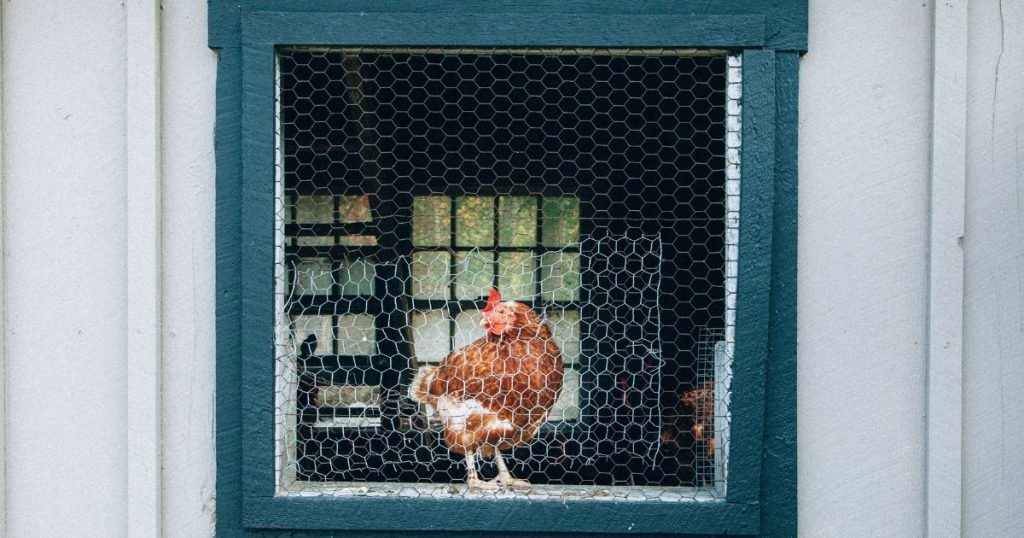Heat, ammonia, humidity, and moisture are common in chicken houses. Ventilation is a must to get rid of these excesses. Flocks usually need more ventilation if they spend more time inside the coop. But how much ventilation chicken coop need?
A chicken coop needs more ventilation during the summer than in winter. For summer months, 3-4 sqft of ventilation is required for every 10 sqft of space. But flocks need around 1-2 sqft of ventilation for 10 sqft of space during winter.
Why A Chicken Coop Needs Ventilation?
Chickens generate a good amount of moisture and heat through breathing and excrement.
Fresh air is vital to control a flock house’s moisture, heat, ammonia, and other substances.
Keeping the surrounding air of chickens fresher, cleaner, and healthier requires ensuring enough ventilation.
Their weight and food conversion rate will be lower due to poor ventilation.
In fact, it may cause different respiratory illnesses. It will increase the mortality rate.
How Much Ventilation Chicken Coop Need?
The amount of ventilation a chicken need depends on various factors.
Climate conditions, coop floor type, humidity, amount of coop space, chicken breed type, chicken growth, tallness of the coop roof, etc., are vital aspects.

High Temperature vs. Low Temperature
Chicken needs more ventilation in hotter weather.
Too much heat increases the air temperature and humidity level.
It may cause heat stress to flocks as they fail to control core body temperature.
They need to release the excess body heat. Otherwise, it will create too much pressure on their body system.
Maintaining good ventilation is a must during hot conditions.
Coop Space
More space means more ventilation.
Maintaining around 4-6 square feet of space per chicken creates a better ecosystem.
Flocks are not overcrowded in a space.
If you keep them in a restricted area, they will feel excessively hot as they breathe into each other closely.
Breed Size
Larger and taller breeds need more ventilation than small-sized ones.
The same rule applies if more chickens live in every square foot of space.
If you have a good collection of massive chickens, maintain enough space for each option.
Increased ventilation is needed if they spend more time inside the coop.
Collections of Windows, Vents, and Doors
How many doors, windows, and vents are in your chicken coop? The more, the better.
It must have a minimum of two windows in the opposite direction. Chickens will enjoy the summer breeze.
Two doors for a chicken coop seem enough too.
Keep one at the entrance and another on the back side near the nesting boxes.
But they need to be predator-proof. Otherwise, dangerous animals and birds will harm them.
Plus, their placements in the right place at the correct angle are crucial to getting optimal ventilation.
Otherwise, “The more, the better” will be a wrong approach.
How Much Ventilation Does A Chicken Coop Need In Winter?
A chicken coop needs around 1-2 sqft of ventilation for each flock in every 10 sqft space.
They don’t require as much ventilation as in hot conditions.
Many chicken farmers close all doors, windows, and vents during the coldest winter months.
It causes releasing too much heat when all chickens breathe together in a confined space.
As a result, the humidity and heat level rise inside the flock house.
Keep one window partially open to allow fresh air to enter. But make sure it is not too much to harm your chickens.
Does My Chicken Coop Need A Window?
Sliding windows are necessary for a chicken coop to keep the interior space well-ventilated.
Flocks will feel warm during the colder months and cool during the hotter months.
Do you know how much sunlight a flock needs? Keeping a chicken exposed to light for around 15-16 hours is essential. Especially, if you have laying hens.
Windows also ensure enough sunlight inside the chicken coop to get beneficial Vitamin D.
It improves the overall egg-laying ability and optimal health condition.
The harmful gasses from chickens’ manure are released through the windows. It protects flocks from inhaling this toxic air. However, composting chicken manure is always a good idea.
Another advantage of coop windows is better accessibility. You can effortlessly clean all areas, especially the hard-to-clean zones.
It also allows you to collect fresh eggs quickly. You don’t have to make out all chickens.
How to Know If a Chicken Coop Has Sufficient Ventilation?
One of the most straightforward approaches is smelling the chicken coop.
If you can sense a higher ammonia level, the chicken coop doesn’t have enough ventilation.
But how to figure out the ammonia level?
Keep your head one foot away from the coop floor. Breathe for a few seconds.
If you experience burning issues in your throat, nose, or eyes, your chicken coop has an increased ammonia level.
If the ceiling, windows, or walls have excess moisture, it can be another sign of insufficient ventilation.
Another trick is turning to light a match. If the fume doesn’t move out slowly, your chicken coop doesn’t have enough ventilation.
How to Ensure Optimal Ventilation in a Chicken Coop?
Drafts are a good choice for hotter months. But they can over-ventilate chickens as airflows directly contact the flocks’ bodies.
If it continues for several weeks, it will make the birds ill. They even die.
Many experts recommended using adjustable vents that let fresh air inside the chicken house without overdoing it.
Usually, you install two vents in the upper position and two in the lower zone to ensure a balanced environment.
These vents are generally covered with weld mesh or clothes to prevent predators from entering.
If you don’t mind spending extra, ventilation fans are the best choice. The fan speed is adjustable.
You can control how much air to let inside the chicken coop.
Final Words
Is this question still popping up in your head: how much ventilation chicken coop need? They need as much as they want to stay healthy depending on the climate conditions, coop size, number of chickens, etc. Your focus should be on ensuring optimal health conditions.
Make sure to install tighter adjustable vents to prevent predators from entering the coop. Also, regularly clean all doors, windows, and vents to let fresh air come more smoothly.



